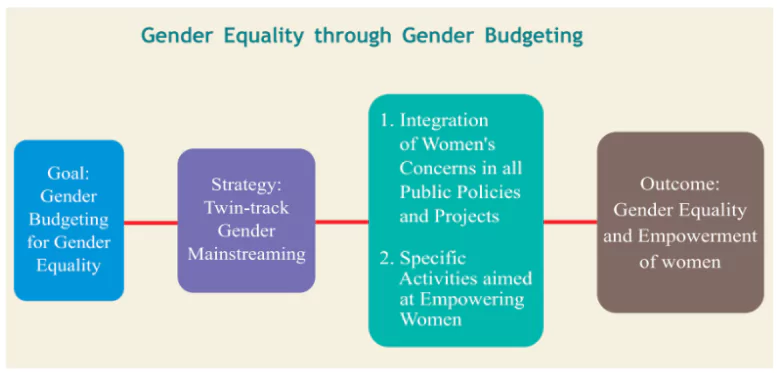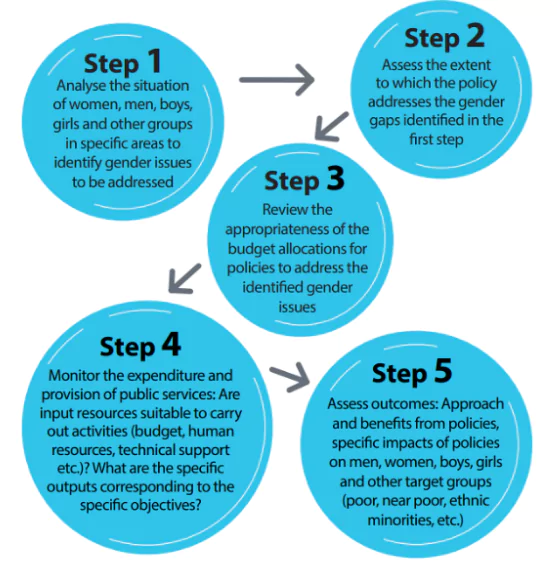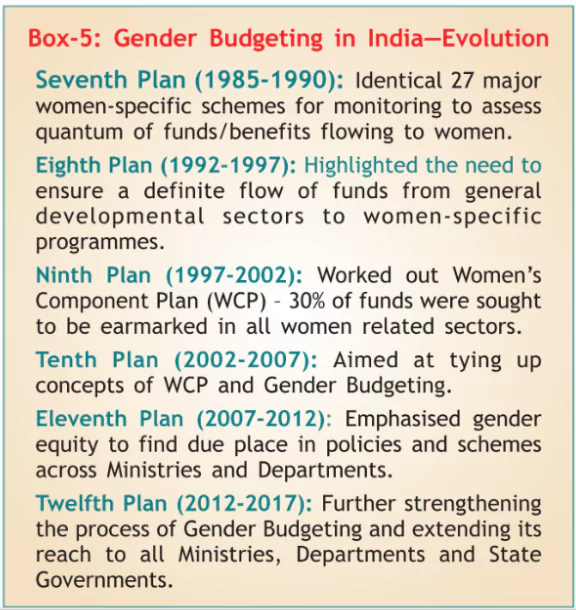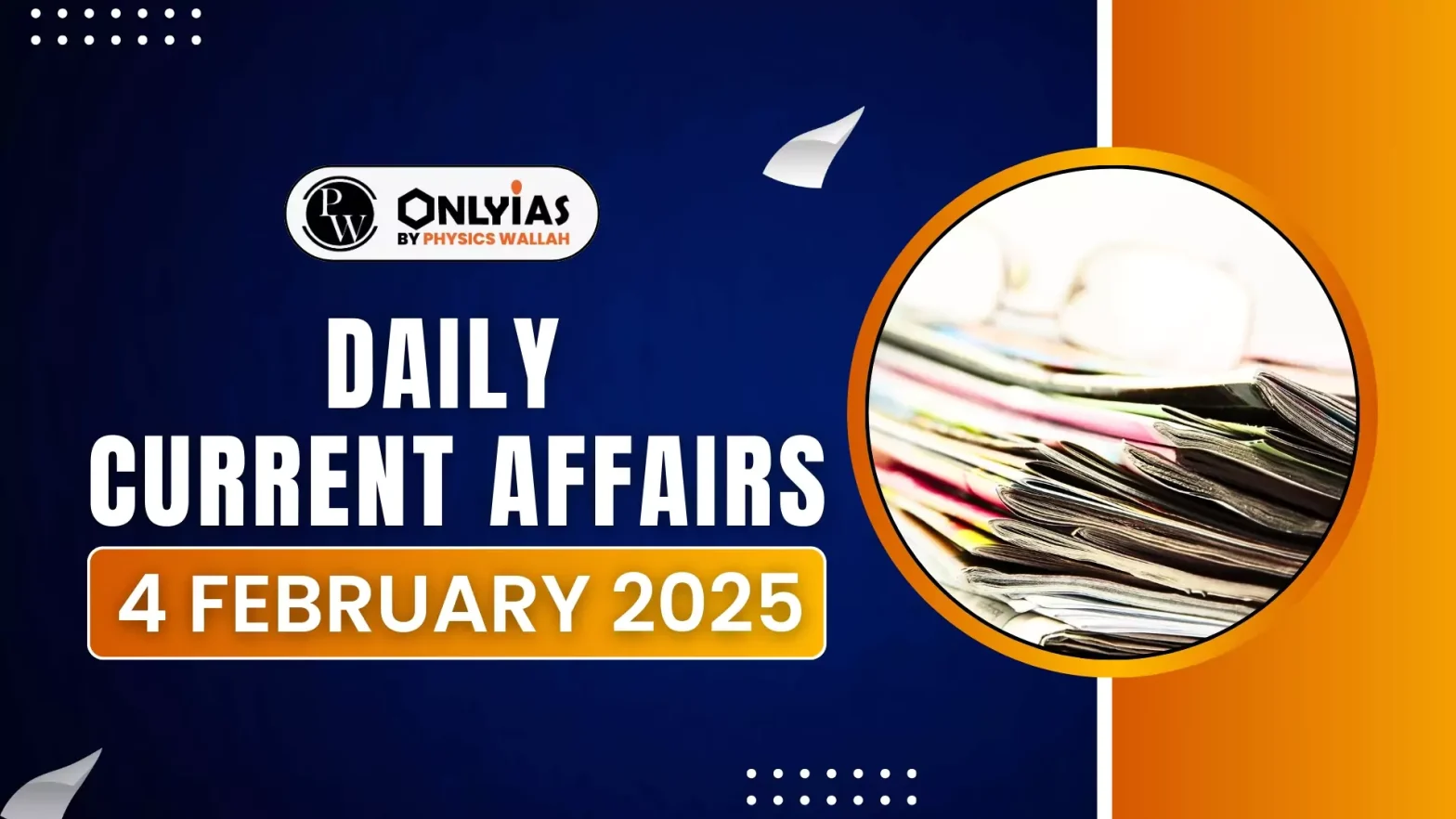The share of Gender Budget allocation in the total Union Budget has increased significantly in Union Budget 2025-26.
Gender Budget Trends
- Increase in allocation: Gender Budget allocation as a percentage of total Union Budget rises to 8.86% in FY 2025-26, compared to 6.8% in FY 2024-25.
- Total allocation: ₹4.49 lakh crore allocated for women and girls’ welfare in FY 2025-26, marking a 37.25% increase from ₹3.27 lakh crore in FY 2024-25.
Enroll now for UPSC Online Classes
Gender Budget Statement (GBS) Components
- Part A (100% women-specific schemes): ₹1,05,535.40 crore (23.50% of total GBS allocation) by 17 Ministries/Departments and 5 UTs.
- Part B (30-99% allocation for women): ₹3,26,672 crore (72.75% of total GBS allocation) by 37 Ministries/Departments and 4 UTs.
- Part C (below 30% allocation for women): ₹16,821.28 crore (3.75% of total GBS allocation) by 22 Ministries/Departments.
About Gender Budgeting

- Gender is a tool for gender mainstreaming which uses the budget as an entry point to apply a gender lens to the entire policy process.
- Gender Budget is not a separate Budget and also not about spending the same on women and men
- Gender Budget covers analyzing various economic policies of the Government from a gender perspective.
- Function: It is a separate statement (not a separate budget) of the Union budget, it provides an estimate of budgetary allocations and expenditure targeted towards women and girls.
- It covers analyzing various economic policies of the Government from a gender perspective.
 Rationale behind Gender Budgeting (GB):
Rationale behind Gender Budgeting (GB):-
- Equality and Efficiency: Apart from the basic principle of promoting equality among citizens, GB can benefit the economy through efficiency gains.
- Keep in Mind the Systemic Differences across Gender: Men and women frequently have different priorities for budgetary policies and a Gender responsive budget can be of great help in addressing women’s concerns from a gender perspective.
- Expectations: When implemented effectively, gender budgeting helps expose how gender inequalities may have inadvertently become embedded in public policies so that resources can be allocated more equally.
- It also helps prioritise budget measures that will support the achievement of key gender objectives.
- The Five-Step Framework for Gender Budgeting by UN Women (refer image)
Difference between Women-led development and Women-Centric Development
Women-led development and women-centric development are both approaches to development that focus on women, but they differ in their focus and approach:
- Women-led Development: It focuses on women taking on leading roles and actively participating in shaping the economic, social, and political progress of a community or society.
- Some of its goals include promoting education, skill development, and entrepreneurship, and bridging the gender digital divide.
- Women-centric Development: It focuses on acknowledging women as an important force in society and integrating them into development programs.
- Some of its goals include improving quality of life, reducing hardship, and building capacity.
|
Evolution of Gender Budgeting

- It was first introduced in 1984 in Australia to evaluate the impact of the national budget on females and the approach was adopted by other countries including Canada, South Africa and Philippines etc.
- United Nations Beijing Platform for Action: In 1995, it called for integrating a gender perspective into government budget processes.
- United Nations Sustainable Development Goals (SDGs): In 2015, it called for adequate resources and tools to track budget allocations for gender equality (SDG 5).
- Addis Ababa Action Agenda for Development: In 2015, it recognised the importance of tracking resource allocations for gender equality and strengthening capacity for Gender Budgeting.
- Women 20 (W20) (an official engagement group to the G20): Founded in Australia in 2014, and it officially began operations in Turkey in 2015.
- In 2020, it called for greater investment in Gender Budgeting to ensure that fiscal policies advance gender equality in the recovery from the COVID-19 pandemic.
- Millennium Development Goals (MDGs): The eight MDGs to which the Government of India is a signatory which includes “Goal 3: Promote Gender Equality and Empower Women”.
Check Out UPSC NCERT Textbooks From PW Store
Gender Budgeting in India
- The Ministry of Women and Child Development (MWCD) recognized gender budgeting as a tool for women’s empowerment in 2004.
- The Ministry of Finance mandated the establishment of GB cells in all ministries by January 2005.
- The charter on Gender Budgeting cells was issued in 2007.
- CEDAW Ratification: India ratified the Convention on the Elimination of All Forms of Discrimination Against Women (CEDAW) in 1993.
- The first Gender Budget Statement (GBS) was published in the Union Budget of 2005-06.
- Different Stakeholders: There are a range of different actors who can be involved in Gender Budgeting.
- Central Level: Ministry of Women and Child Development (MWCD).
- State Level: Departments of Women and Child Development, Social Welfare, Finance, and Planning.
- District Level: Hub for Empowerment of Women (HEW) coordinates gender budgeting, with at least one gender specialist.
- Role: The gender budgeting framework has helped the gender-neutral ministries to design new programs for women.
- Over the past two decades, India’s GBS has evolved into a comprehensive document that provides item-wise allocation and expenditure details in a clear, predictable format.
Significance of Gender Budgeting
- Promotes Gender Equality: Gender Budgeting (GB) ensures that financial allocations address gender disparities, supporting Sustainable Development Goal (SDG) 5 on gender equality.
- Informed Policy Choices: GB helps policymakers consider the gendered impact of policies, ensuring that women’s concerns are integrated into financial planning.
- Better Utilization of Resources: A well-designed GB framework enables optimal utilization of resources to bridge gender gaps in education, health, employment, and social security.
- Strengthening Legal Frameworks: It aligns with women-specific laws such as the Criminal Law Amendment Act, 2013, and the Sexual Harassment of Women at Workplace Act, 2013, by ensuring financial backing for implementation.
- Wider Societal Impact: Studies, including an IMF working paper on G20 countries, have shown that GB leads to gender-responsive programming, positively influencing economic growth and social development.
- Addressing Gender-Neutral Budgeting Pitfalls: Traditional budgeting often ignores gendered impacts. GB ensures that all major budgetary allocations consider women’s specific needs and roles in the economy.
- Transparency and Accountability: GB fosters transparency in fund allocation for women-focused schemes, ensuring accountability in implementation and impact assessment.
Challenges with Gender Budgeting in India
- Ambiguities in Allocation: Discrepancies exist in fund classification. For instance, MGNREGS is underreported in Part B of the Gender Budget, despite women comprising over 59.3% of the workforce.
- PMAY-G Discrepancy: Although categorized under Part A (100% allocation for women), only 23% of houses have been allotted to women.
- Concentration of Funds in Select Ministries: Nearly 90% of the gender budget is concentrated in a few ministries, limiting its reach across diverse sectors like technology, infrastructure, and entrepreneurship.
- Long-Term Schemes Diverting Focus: Programs like Ayushman Bharat and Awas Yojana, though beneficial, divert funds from immediate-impact programs like Mission Shakti and female education initiatives.
- Weak Monitoring and Evaluation Mechanisms: Lack of gender-segregated data hampers accurate measurement of policy effectiveness.
- UN Recommendation: Calls for enhanced collaboration between the Ministry of Women & Child Development (MWCD) and the Ministry of Finance to strengthen sectoral monitoring.
- Technical and Data-Related Challenges: Without granular data, it is difficult to track the effectiveness of GB.
- NITI Aayog’s 2022 Report: Only 62 out of 119 centrally-sponsored schemes practice gender budgeting, highlighting inconsistent implementation.
- Under-Reporting and Over-Reporting Issues:
- Over-Reporting Example: PM Employment Generation Programme (PMEGP) allocated 40% of its funds under GB without clear justification.
- Under-Reporting Example: The Mahatma Gandhi National Rural Employment Guarantee Scheme (MGNREGS) mandates that at least one-third (33%) of its allocation must be reserved for women though the women’s participation has exceeded this threshold, with around 50% of workers being women.
- The GBS reports 47% of the total MGNREGA budget for women in FY 26.
- Lack of Political Will and Accountability: No mandatory minimum allocation for GB exists, leading to inconsistent support and inadequate monitoring.
Way Forward for Gender Budgeting in India
- Strengthen Institutional Mechanisms: Mandate the creation of GBCs in all ministries and departments at both central and state levels.
- NITI Aayog should play a proactive role in monitoring and evaluating the implementation of Gender Budgeting across ministries and states.
- Improve Data Collection and Analysis:Invest in collecting and analyzing gender-disaggregated data to better understand the needs of women and girls.
- Conduct gender impact assessments for all policies and programs to ensure they address gender disparities effectively.
- Increase Allocations and Ensure Proper Utilization: Increase the share of Gender Budgeting in the total Union Budget to at least 10-12% to address persistent gender gaps.
- Monitor the utilization of funds to ensure they are spent as intended and reach the target beneficiaries.
- Expand the Scope of Gender Budgeting: Integrate Gender Budgeting across all sectors, including infrastructure, agriculture, and rural development, to ensure gender-sensitive allocations in every government initiative.
- Ensure that marginalized women, such as tribal women, rural women, and women with disabilities, are included in development programs.
- Enhance Transparency and Accountability: Ensure transparency in the allocation and reporting processes by publicly disclosing the methodologies used to allocate funds.
- Conduct gender audits across ministries to evaluate the effectiveness of the allocated funds and make necessary adjustments.
- Strengthen Legal and Policy Frameworks: Introduce a Gender Budgeting Act to mainstream gender-based budgeting across all ministries and states/UTs.
- Ensure that Gender Budgeting aligns with Sustainable Development Goal 5 (Gender Equality) and other related goals.
- Promote Women’s Economic Empowerment: Expand programs like Stand-Up India and Mission Shakti to promote women’s entrepreneurship and skill development.
- Provide access to credit and market linkages for women-led businesses.
Enroll now for UPSC Online Classes
Conclusion
A stronger Gender Budgeting framework can help India move closer to achieving gender equality and women-led development. By improving transparency, accountability, implementation, and monitoring, Gender Budgeting can become a powerful tool for women’s empowerment and inclusive economic growth.
Ready to boost your UPSC 2025 preparation? Join PW’s UPSC online courses today!
![]() 4 Feb 2025
4 Feb 2025


 Rationale behind Gender Budgeting (GB):
Rationale behind Gender Budgeting (GB):
